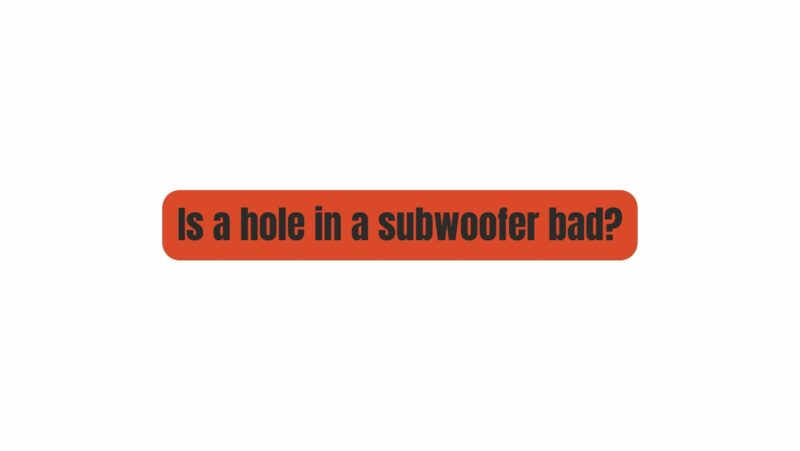Before we address the issue of holes in subwoofers, it’s essential to grasp the significance of these components in audio systems. Subwoofers are specialized speakers designed to reproduce low-frequency sounds, commonly referred to as bass. They enhance the overall audio experience by providing depth, richness, and impact to music, movies, and games. Without a functioning subwoofer, the audio output lacks the powerful low-end frequencies that add vibrancy and realism to the sound.
Subwoofers come in various sizes and configurations, from small car audio subs to large home theater or professional audio subs. They typically consist of a cone-shaped driver mounted in a sturdy enclosure, and they are driven by an amplifier to produce deep bass notes.
Identifying Damage: Is That a Hole in Your Subwoofer?
Subwoofer damage can occur in several ways, including physical mishandling, overdriving the speaker with excessive power, and even age-related wear and tear. A common manifestation of damage is the presence of a hole or tear in the subwoofer cone, which is the part of the speaker responsible for generating sound waves.
A hole in a subwoofer can take various forms, including:
- Small Puncture: This is typically a tiny hole or tear in the cone material. It may not be immediately noticeable but can still affect sound quality.
- Large Tear: A more substantial tear or hole in the cone is usually more evident and can result in a significant reduction in sound quality.
- Completely Blown Cone: In severe cases, the cone may be completely blown apart, rendering the subwoofer non-functional.
Now, let’s address the pressing question: is a hole in a subwoofer bad? The answer largely depends on the size and location of the hole, as well as your expectations for audio quality.
The Impact of a Hole in a Subwoofer
- Sound Quality: The most noticeable impact of a hole in a subwoofer is a degradation in sound quality. The hole disrupts the flow of air within the speaker, causing distortion and a loss of low-frequency response. This results in weaker bass and less overall clarity in the audio output.
- Reduced Efficiency: A damaged subwoofer is less efficient in converting electrical energy into sound. This means it requires more power to produce the same level of bass as an undamaged subwoofer, potentially overloading your amplifier.
- Risk of Further Damage: A small hole can sometimes lead to more extensive damage if not addressed promptly. Vibrations and stress on the damaged area can cause the hole to expand, further compromising the subwoofer’s performance.
- Aesthetic Concerns: If the subwoofer is visible in your setup, a hole or tear can be unsightly. While this doesn’t directly affect audio quality, it may be a cosmetic issue you wish to address.
Repair Options for a Subwoofer with a Hole
Now that we’ve established that a hole in a subwoofer can indeed impact its performance, the next question is whether it can be repaired. The feasibility of repair depends on the extent of the damage and your level of expertise or willingness to seek professional assistance. Here are some repair options to consider:
- Patch or Seal Small Holes: If the hole is small, you may be able to patch or seal it using a suitable adhesive or patching material. Be cautious when attempting this, as improper repairs can worsen the problem. Seek guidance from experts if you are unsure.
- Recone or Refoam: For more extensive damage, reconing or refoaming the subwoofer is an option. This involves replacing the damaged cone or foam surround with new materials. This is a delicate procedure that is best left to experienced technicians, as it requires precise alignment and calibration.
- Professional Repair Services: Many audio repair shops offer services specifically for subwoofer repair. They have the expertise and equipment to assess the damage accurately and perform the necessary repairs. While this can be more expensive than DIY options, it ensures a professional and reliable fix.
- Consider Replacement: In some cases, especially if the damage is extensive or the subwoofer is old, it may be more cost-effective to replace the entire subwoofer rather than attempting repairs.
Preventing Subwoofer Damage
The best approach to dealing with subwoofer damage is to prevent it from happening in the first place. Here are some tips to help you protect your subwoofers:
- Proper Handling: Be gentle when moving or installing your subwoofer to avoid physical damage.
- Match Amplifier Power: Ensure that your amplifier’s power output matches the subwoofer’s specifications to prevent overloading and damage due to excessive power.
- Use Protective Grilles: Many subwoofers come with removable grilles that can protect the cone from accidental damage.
- Regular Maintenance: Periodically inspect your subwoofers for signs of wear and tear, and address any issues promptly.
Conclusion
In conclusion, a hole in a subwoofer can indeed be bad, as it can lead to a deterioration in sound quality and other performance issues. The severity of the damage will determine whether repair is a viable option. Small holes may be patched, while more extensive damage may require professional attention or even a complete replacement.
To ensure the longevity of your subwoofer and maintain optimal audio quality, it’s crucial to handle your equipment with care, match it with an appropriate amplifier, and perform regular maintenance checks. By doing so, you can enjoy that deep, powerful bass for years to come without worrying about the dreaded hole in your subwoofer.


